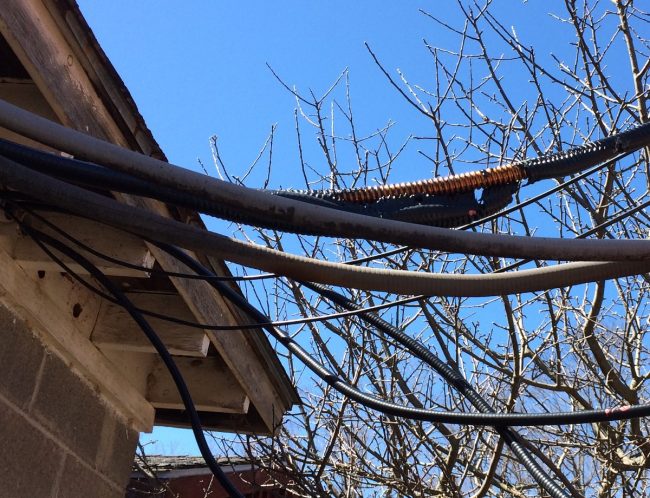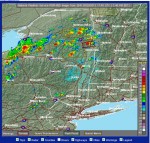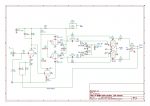Apparently, this coaxial cable has a hot spot:

The back story:
I received a text this morning that one of our client’s stations “had a lot of static on it, it might be off the air.” Upon arrival, I found the Nautel VS2.5 transmitter with 0 watts of forward power and an output network fault. Reset the transmitter and the forward power and reflected power increased together, triggering another output network fault. I was able to turn the transmitter power down to 100 watts, at which point it stayed on, with 50 watts reflected power. I also noted the dehydrator running continuously and 0 PSI line pressure.
Crap.
I wandered around the back of the building where the coax goes out to the tower and discovered the dripping plastic from the melted jacket. I reached up and first checked the cable to see if it was warm (it was not). Then I shook it and heard what I thought was water sloshing around inside. This is the original Andrew 7/8 inch cable from when the station signed on in 1972 or so. Very likely that further up the tower, something has chaffed through the outer jacket and shield, allowing water into the cable.
I drilled a small 5/32-inch hole at the lowest point in the cable before it enters the building. The result was a steady stream of water, which was aided by some additional pressure from a spare N2 tank. I let it drain while I ran down to town and got some lunch. I came back half an hour later, turned the transmitter on, and was satisfied to see 100 watts of forward power with 1 watt reflected. I ran the transmitter up to full power for a while, then deciding discretion is the better part of valor, and turned it down to half power; 820 watts which net 8 watts reflected power.
Needless to say, the transmission line needs to be replaced as soon as possible.






Ouch!
Is that 3-1/8 cable or are my eyes playing tricks?
Nautel transmitters are VERY sensitive to reflected power (as you saw) and will foldback in a heartbeat. So, how did the feedline get hot enough to melt the insulation? Was a previous brute force transmitter replaced thinking it was a transmitter issue instead of a feedline issue?
Does anyone ever check the pressure on the coax…I mean, duh? How do you get that much water in a coax without someone knowing it has a problem? Doesn’t somebody check readings on the transmitter? You gotta know that something is not right when the power starts to drop, that don’t happen overnight.
It could be lightning related too, usually that will melt through stuff, but not always. What probably happened is that the water had been filling up in that part of the coax and the RF caused it to arc or vaporize the water, and then it got hot. But when I see a transmitter shut down or full reflected power, shorted coax is the number one suspect. But you gotta know long before that point that something is wrong. Maybe the station was fully operated by computer?
I guess you use it as long as you can.
Chuck, it is 7/8 inch line.
Scott, the Nautel transmitter has been installed for two and a half years, however the previous transmitter was a McMartin BF3.5A, which is indeed a brute force unit.
Здравствуйте, Нил! Yes, we check the pressure periodically, unfortunately, there is no pressure loss alarm hooked to the remote control, which will change when we install the new dehydrator. replacement parts are on order
All you need is someone to put a bullet in your line and you have instant failure. It doesn’t HAVE to be a slow, evolving event.
A pressure sensor is not that expensive and is a good investment.
I should have said, “put a bullet HOLE in your line.” Most RF transmission lines have a bullet or two…
LOL, Tom. Yes, we will do a complete autopsy on the old line and figure out why it failed.
wow, bad but I got one worse, can I send you my pix
You know, I guess I “assumed” something here, but is it possible that the engineer that installed the new transmitter didn’t purge the line of air?
If you pressurize the line with nitrogen, and either didn’t know already, or didn’t read the instructions (duh), you must purge air out of the line. Usually, you either have open a bleeder at the splitter side on the top near the antenna, or you can run a few tanks of nitrogen through it and purge it at the transmitter side. Air always contains water. Water should never leak in also long as the coax is under pressure. But if there is air already in the coax because the air was not purged out, or the nitrogen canister had air in it, that can cause condensation to form and run down the coax. If someone used AIR instead of nitrogen, that could cause the problem as well!
For god’s sake, put a couple of alarms on that unit, one for the pressure level and one for the reflected power level. As far as I know, you can patch a coax using copper, thick lead, flux, and a hot soldering iron, it is pretty much like plumbing.
But another warning, if the coax is very old, you might want to inspect the tower using binoculars or a telescope – if the tower is falling apart, the tower mignt be held up by the coax, where the coax is compressing and breaking due to the weight of the tower! Towers typically sway, and coax can break from bending back and fourth. Thus, tower climbers should be careful and use multi-staged harnesses on these, as the tower may have bad bolts at the top. I would have to see the tower to know what kind of assembly it uses.
Lightning is most often the cause of failure. But if someone put air in the line, that would do it, or if someone neglected to let the air out of the line when filling it with nitrogen, that could cause a problem. Think of the mechanical concept of an enema, one end is plugged and the other end is open and you cannot access one end.
I also didn’t ask the question…Is the tower use for AM? I would presume that any engineer would know that when you mount an FM antenna on an AM tower that you need to use a high power isolation transformer…usually you will see one at the end of the coax on the tower side….but again, ass-ume.
But yes, the coax can obviously arc internally if there is humid air in it, and cause the coax to get hot and burn out…as the system has a tower attached to it, you probably won’t have issues with 9 legged frogs, meaning RF will be absorbed by the ground.
If there is not a budget for a pressure gauge alarm, you can simply take apart a pressure gauge, super glue a small magnet on the gauge pointer, and then super glue a reed switch on the front, so that it trips the reed switch when the gauge gets too low. What transmitter doesn’t have a reflected power alert warning? You could hook a simple sensing circuit to the meter to trigger an alarm relay.
Most stations I know of have a monitoring unit that reports readings back to the studio. Is it possible that this station had an engineer onsite most of its life, and was sold when the engineer died or retired?
I also see other coax cables.
Most nitrogen leaks that I’ve seen were due to coaxes rubbing something. They can wear through or break at a connector. If the hole is small, just epoxy is an adequate fix.
A quick way to dry out a line is to use a vacuum pump before injecting dry nitrogen. The kind used by HVAC techs work well, $99.99 at harbor freight. It’s handy to have a manifold with gauges to tie the vacuum pump into the line.
Engineers hate having to tell the station owners that “we got this far and spent this amount of money” and now we found it is gonna cost MUCH MORE THAN EXPECTED!
Another guess on this one, I don’t see where the coax meets the tower….that coax is getting horizontal, is it getting kinky?. Is it possible that the coax was too tight and is being pulled at a 90 degree angle at the tower? Sometimes one has to check the obvious. If the coax was kinked and it broke, it would certainly fill with water. If it was bent enough, the center conductor can short out. You need a drip loop. Also, in northern states, ice and snow builds up on on areas like this, and could cause leaks or damage. There is very little drip loop on this, from the picture.
But, for god’s sake, usually the transmitter’s problems are related to the antenna system! This one looks to me like an amature mis diagnosed the problem. It could also be that the station owner didn’t understand the problem, or RAN OUT OF MONEY and couldn’t afford to replace the coax.
Every station, depending on the size of the market, should run a piece of RG-11 coax up the tower and install a 1 bay dipole antenna for a 100 watt backup. I live in an area that has a county-run LPFM oldies station that runs at around 50 watts. The local commercial station has slightly better coverage….but the LPFM covers in the clear in the target market. Needless to say, a weaker signal only affects the more distant listeners, 100 watts will do well in most markets on a channel that is cleared for 10,000!
Forgot to mention the vacuum pump, that works well, probably better than purging it, either way you still have to get the air out and nitrogen in. It is much faster to do it that way… but….the only problem with that is if you have a slow leak, you are sucking more air into the coax. If it has a slow leak, there probably won’t be too much air as nitrogen keeps getting added. (in this case nobody added nitrogen or the let it run out or added air. But HVAC methods apply here.
With the purge method, the goal is to mix nitrogen with existing air and then blow it out, decreasing the percentage of air each time you add nitrogen. With the vacuum, you get most of the air out, but there is a threshold on how much vacuum you can pull on a coax. The only problem is that if there is a leak, the vacuum will suck more air in.
But if it is a new system, (new coax, etc) and you have someone on the tower already, purge it from the top. I’ve used one of those for air conditioning work and it is certainly good enough for the $99.
The epoxy will work fine too, the only thing is that copper and epoxy often break down chemically (ask Mitsubishi lol). The danger of soldering is getting it too hot, you don’t want to melt the helix that holds the center conductor. It all depends on the time frame you have to get it done…soldering dries / cools instantly. But if it somewhere up the tower in the winter time, i’d use the epoxy too!
And yes, forgot to mention hot neutral and earth, if the AC transformer in the transmitter had a short, you could get HOT AC grounding to the tower.
How much power was being sent through this?
if I walked around and saw that two words that begin with the letters J & C. What a mess, glad you could get back to decent power level. The autopsy should be interesting to see what could have happened.
Can anyone out there help me to find a place to get an Andrew MT-300 dehydrator repaired that won’t cost me and arm and a leg and take forever?
Had a problem once with a control cable that corroded a connector in the operators position inside the controlled space of an aircraft hanger. Situation was a 150′ run from the roof of the hanger through a wall separating ambient from the cool dry operators space. It had been decided prior to my arrival that a hole in the cable jacket and the cure was replacement. What was found upon removal of the old cable was no holes and pressure testing on the cable with both ends sealed found it held pressure and upon unsealing the end while adding compressed air moisture soon was dripping. Later experiments and watching the PM work it was decided that it was the Second Law of Thermodynamics doing it to the cable. Each quarter when the tuner was cleaned and inspected warm, moist area was introduced to the system and all it took was the effects of gravity and the condensing water to pump it into the cool, dry space. Sometimes good practices seem to work against you.